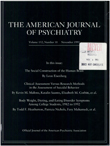Quality of life and psychiatric morbidity in panic disorder and generalized anxiety disorder
Abstract
OBJECTIVE: This report examines the impact of panic disorder and/or generalized anxiety disorder on quality of life and the implications of these findings on nosological categories. METHOD: A total of 357 subjects with a current episode of panic disorder and/or generalized anxiety disorder were diagnosed according to DSM-III-R criteria, using structured clinical interviews, as part of a prospective, naturalistic, longitudinal, multicenter study of a clinical population with anxiety disorders. RESULTS: There was a high degree of coexistence of anxiety disorders and major depressive disorder. Subjects with generalized anxiety disorder almost universally had other disorders, were the most likely to have at least one other anxiety disorder or major depressive disorder at intake, had the earliest age at onset, and had the worst emotional health rating. Subjects with panic disorder without agoraphobia had the most likelihood of a history of alcohol abuse. Nine percent of the subjects had a history of suicide attempts or gestures. CONCLUSIONS: The subjects showed significant impairment in quality of life. The highly frequent coexistence of other anxiety disorders with generalized anxiety disorder and the overall lack of differences on many quality of life measures raise questions of nosology, particularly for generalized anxiety disorder.
Access content
To read the fulltext, please use one of the options below to sign in or purchase access.- Personal login
- Institutional Login
- Sign in via OpenAthens
- Register for access
-
Please login/register if you wish to pair your device and check access availability.
Not a subscriber?
PsychiatryOnline subscription options offer access to the DSM-5 library, books, journals, CME, and patient resources. This all-in-one virtual library provides psychiatrists and mental health professionals with key resources for diagnosis, treatment, research, and professional development.
Need more help? PsychiatryOnline Customer Service may be reached by emailing [email protected] or by calling 800-368-5777 (in the U.S.) or 703-907-7322 (outside the U.S.).



